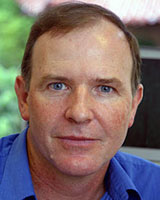Introduction
The difficulty in attracting and retaining professionals to rural and remote areas in Australia are well documented1. In the Northern Territory (NT), where only the greater capital Darwin region is not classified as remote, the economic and social impacts of the combination of skills shortages and difficulties in recruiting professionals are significant. Darwin's distance from other Australian cities, its small size and its tropical climate creates some difficulties in attracting workers. The communities outside the greater Darwin region face an even greater array of impediments to developing their economies and the efficient delivery of basic services. Building a sustainable population mass and attracting enough skilled workers to match the NT's requirements is a priority for the NT Government2.
Workforce issues faced by remote Aboriginal communities in the NT (and in similar demographic areas such as northern Western Australia, northern South Australia and Queensland), are different from the issues experienced in rural communities elsewhere in Australia. Similarly, the unusual demographic characteristics of the state, with its small, young and widely dispersed population, high proportion of Aboriginal people and high non-Indigenous population turnover3 indicate that principles of workforce management that apply in other jurisdictions may not be relevant in the NT. Tailored approaches to the recruitment and retention of a skilled workforce are needed and these will rely on the provision of information specific to the NT.
The dental workforce, like other medical and allied health professions, is characterised by an uneven geographic distribution of the limited number of practitioners. In Australia, the average number of dentists is below that of many other OECD countries4 and there is evidence of impending shortages in supply5. Differences exist in the level of dental service provision between states, capital cities and between metropolitan and regional centres4,6. In 2001, the NT had only 30 dentists per 100 000 people, relative to the national average of 43. Future shortages are likely to be felt most acutely in rural and remote areas where residents are already disadvantaged in terms of the supply4,7 and form8 of dental care. Such shortages are likely to not only affect oral health, but also to exacerbate poor health in some sections of the community (eg see9-13). As the demand for dental services rises in response to Australia's ageing population14, competition for dental professionals is likely to become more acute, with particular ramifications for more geographically dispersed or isolated regions.
In a climate of competition for skilled workers, people whose skills are in demand are likely to be highly mobile, responding to higher wages and work opportunities. Hence their migration patterns are characterised by opportunistic transience rather than permanent movement15,16. While some turnover can act to maximise productivity17, elevated levels incur high costs and cause disruption to services18,19. Understanding the characteristics of staff mobility and the factors influencing retention should lead to enhanced service delivery through the provision of a more stable workforce.
Numerous surveys and studies have looked at the factors important to recruiting medical and allied health workers generally20-26 and to rural locations19,27,28. There is evidence that medical and nursing students with a rural background are more likely to select work in rural areas, and that a high quality, practical placement in a rural centre will encourage urban students to consider rural placements29-32. The process of selecting new staff has also been found to be significant, with greater success recorded when communities are actively involved in the recruitment process33. Country dentists are most commonly attracted to rural locations by a combination of lifestyle and work opportunities, including the opportunity to establish their own practice34.
Staff retention, or turnover, has been correlated to a range of variables, including job satisfaction22,25,26, career satisfaction35, group cohesion35, professionalism36 and autonomy37. Job satisfaction, seen as critical to reducing voluntary turnover in business organisations, has been the subject of a number of theories26,38,39 covering a range of specific variables. It has been examined in some detail in a variety of medical and allied health professions. For example, it has been related to work content and work environment (rather than economic or individual variables) in nurses40, and with resources, autonomy, and relationship with colleagues (not to compensation and administrative responsibilities) in dentists from Victoria41. Studies of workforce issues affecting the retention of oral health professionals in Australia show that gender, age and practice influence the level of satisfaction along with various aspects of employment including the amount of personal time, relationships with colleagues, patients and staff, community and administrative responsibilities, and level of autonomy, compensation and resources34,42.
Research conducted overseas and in Australia has shown that job satisfaction should not be considered in isolation from environmental and social factors, particularly when accounting for job retention or turnover in rural health workforces29,43-45. Similarly, surveys conducted by the Australian Psychologists Society46 and of professionals working in Australia and New Zealand21 both found that, while income-related incentives play a role in attracting skilled workers, job satisfaction and enjoyment of lifestyle, that is the social and physical environment, are critical to the successful retention of these individuals. These findings indicate that the decision of an employee to stay or leave is a function of a constellation of factors related to people, things, groups and institutions including factors external to the organisation in which they work. Embeddedness, as this is termed47,48 has been shown to predict turnover over and above a combination of movement measures including job satisfaction, organisational commitment and job alternatives49.
This theory is supported by the experience of communities who have succeeded in the retention of critical workforce participants by ensuring the integration of health professionals and their families into the community33. However, other research indicates that work factors far outweigh the influence of social and external factors when predicting voluntary turnover. For example, an investigation into the patterns of medical workforce retention in rural and remote communities found that professional factors (vocational satisfaction, support, remuneration, physical conditions etc) were more important in determining how long a GP remained in a rural or remote practice than were social or external factors relating to the personal characteristics of the family, community or the practice's geographical location. Further, the importance of these professional factors was modified by demographic characteristics such as gender and age50, rather than factors relating to community embeddedness.
Employee turnover is commonly described in terms of the 'turnover model'51 where turnover is viewed as a two stage process: first, the identification of a desire to leave and, second, the identification of a viable alternative28. For professionals working in a field where there is a skills shortage, a viable alternative to an existing less satisfactory position are easily found. A study of GPs leaving rural practices in western Victoria and Queensland29,52 proposed a model in which rural retention was viewed as an interplay of both positive and negative influences with acute trigger factors, such as conflict with management (work related) or education for children (a social factor), that can precipitate the decision to leave. The framework suggests that rural retention can be seen as a balance of fairly constant positive factors that influence both recruitment and retention which are gradually counteracted by increasing and ongoing negative factors. The balance may be tipped by an acute trigger factor.
This study was undertaken to identify factors influencing the decisions of a specific group of professionals, dental practitioners, to move to or from the NT. The motivations and the demographic and social characteristics of dentists, dental therapists and oral hygienists are explored within the context of their length of stay. The study investigated the importance of both professional (work-related) and social (non-work related) factors when NT dental professionals chose to come to, and to leave, the NT.
Methods
The study of dental practitioners and associate dental professionals (as defined by Australian Bureau of Statistics occupation categories) was undertaken using a modified Delphi approach. Professional associations representing dentists and dental therapists were consulted to elicit their support for the research. They sponsored the study by nominating members for stage-one interviews and by actively promoting it to their members through newsletters and on their web pages, both before the survey and in the weeks following the mail out, requesting that members participate in the survey.
Twenty dental professionals (dentists, dental specialists, dental therapists and dental hygienists) with a range of experience living and working in the NT were interviewed to determine which factors influenced their personal decisions to move to, remain in or to leave the NT. These results were used to develop a self-administered questionnaire that asked participants, including those previously interviewed, to indicate the importance of these factors in their decisions concerning mobility.
The questionnaire was used to survey dental practitioners (dentists and dental specialists; hereafter termed dentists) and associate dental professionals (dental therapists and dental hygienists, hereafter termed associates) who were working in the NT in 2005. The questionnaire and a letter explaining the benefits of the research to the profession was mailed to all dental professionals registered with the NT Health Professionals Licensing Authority in 2005 and, where possible, to dental professionals who had previously been registered in the NT but were currently registered with other dental boards. The sample of professionals who had worked in the NT but were no longer resident in the NT was increased by advertising in relevant publications. Advertising, conducted 4 weeks after the initial mail out, reminded those who had previously received questionnaires to respond. A total of 173 questionnaires were mailed.
The survey captured basic demographic data (age, place of birth, residence status in Australia, sex), information about the respondent's mobility (period of residence in the NT, information related to household structure at various times relative to migration, involvement in community groups) and work and training characteristics (profession, professional training, time since qualifying, an estimate of professional turnover within the practice, and indicative data related to the impact of turnover on the efficiency of service provision). It also collected data related to motivational factors influencing migration decisions. Within each category, factors were separated into work-related and social issues, providing a matrix of 52 statements related to work-related issues and 28 statements related to social issues. Responses to these statements were captured on a five-point Likert scale ranging from strong disagreement to strong agreement. The questionnaire also asked for respondents to comment on their migration experience. These comments were analysed to supplement the quantitative data collection.
Statistic analysis
Chi-square tests were used to compare demographic, professional training or workforce characteristics between dentists or associates who remained in the NT for 5 or more years (long stayers) and those who came to the NT but left within 5 years (short stayers). Univariate unadjusted relationships for all socio-demographic variables were checked against length of stay. Those who showed a moderate relationship (p<0.10) were then entered into a backward stepwise (conditional) logistic regression model and the adjusted relationship between stay length and socio-demographic variables was obtained.
Data related to motivational factors were subject to principal component analysis (PCA) to identify inter-relationships between sets of factors to produce a set of orthogonal components that summarise the variation in the original data. PCA processing reduces the dimensionality of the data by finding the directions of maximum variance within the dataset, scaling the variance along different directions and giving each axis, or cluster, equal weight53. PCA with a varimax rotation was performed on each set of reasons (social and work-related) for the three domains of mobility (reasons to come, reasons to remain, and reasons to leave). Component scores were generated from the varimax rotated PCA solutions to establish a new set of variables with low levels of correlation. These were used to generate multivariate logistic regression models to describe the reasons why dental professionals stayed in the NT for more than 5 years and to analyse why dental professionals left. These models were adjusted for current residential address and age of respondent.
Results
A total of 73 questionnaires (42% of those mailed) were completed and returned. Responses from practitioners who were no longer practising or not resident in the NT were excluded from the demographic description of the dental professional population resident in the NT at the time of the survey. This was thus based on a sample of 43, 29 dentists and 14 associates. All responses were included in the analysis of motivational factors.
A demographic profile of the respondents currently resident and working in the NT is shown (Table 1). The 2005 sample had a significantly greater proportion of associates younger than 30 than recorded in the NT in 2001, more were women and fewer were born overseas. Dentists who responded were older than those recorded in the NT during the 2001 census and had a higher proportion of dentists born overseas who are not Australian citizens.
Compared with the rest of the country, a higher proportion of the associates in the NT were women at the time of the 2001 census but the age structure, place of birth and citizenship resembled the national average. Dentists in the NT in 2001 were significantly younger than for the whole country, but the proportion who were female, born in Australia or were Australian citizens was no different to the proportions nationally.
Table 1: Demographic characteristics of dental professionals working in the Northern Territory in 2005, as compared with 2001 and the 2001 national average (from Australian Bureau of Statistics Census of population and housing 2001)
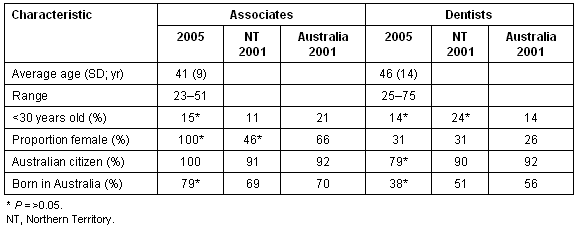
Fifty-four dentists and 17 associates completed the questions related to motivations for coming to and staying in the NT. Of these, 23 respondents, 15 dentists and 8 associates, had or were about to leave the NT and also completed the section related to motivations for leaving. Fifty-nine percent of associates and 52% of dentists had lived in the NT for more than 5 years.
The associates who had stayed more than 5 years tended to be older, more likely to have attended high school in the NT, to be engaged in home ownership, be living with family and be engaged with professional or other community groups (Table 2). Long-staying dentists had similar characteristics, but recent arrivals were, in addition, less likely to hold Australian citizenship. Rural upbringing did not appear to influence tendency to stay in the NT. Dental professionals who attended high school overseas were more likely to be new arrivals (<5 years).
Table 2: Characteristics of dental professionals with experience in the Northern Territory
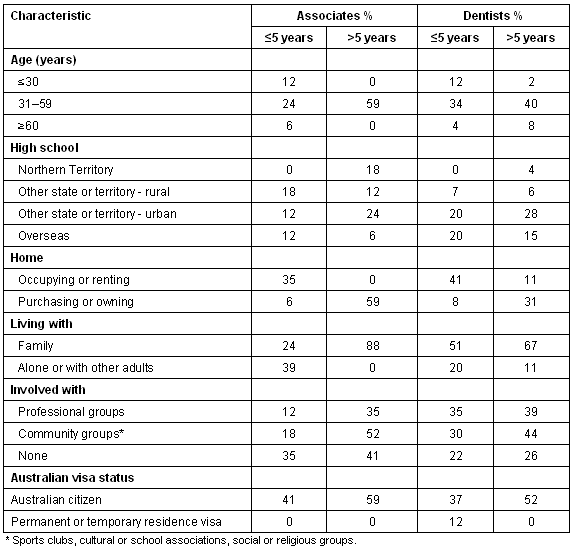
Statistical modelling indicated that between 60% and 80% of the variation in length of stay is explained by the socio-demographic variables alone. Dental professionals who stay in the NT for >5 years tend to be older; are buying or own their place of residence in the NT and are more likely to be engaged in professional, social and cultural group activities.
Factors influencing decision to come to the NT
A four-factor solution was obtained for the 13 variables relating to work factors influencing dental workers to come to the NT (Fig 1). Factors which broadly reflect individual perceptions regarding the distinctive nature of dental work in the NT accounted for 26% of data variation. Incentive driven reasons for coming to the NT combined with reasons relating to business setup and work experience accounted for a further 16% of data variation followed by a grouping of financial and labour market considerations (11%), while the fourth component (10%) group reflectied personal reasons for coming to the NT.
A four-factor solution was also obtained for the 13 variables relating to social factors influencing decisions by dental workers to come to the NT (Fig 2). This accounted for 68% of the variation in the original 13 variables. The first, reflecting respondents' personal preferences for new experiences relating to the NT lifestyle, accounted for 25% of variation. A further 20% of variation is accounted for positive prior perceptions about living in the NT. The third component (13%) grouped respondents who had prior knowledge or connections with the NT, and the fourth (11%) grouped respondents who had come to the NT for personal lifestyle reasons.

Figure 1: Work-related reasons for coming to the Northern Territory among dental professionals (proportion of respondents; dark: very important; mid-grey: indifferent; white: not at all important; priorities sorted from high to low for long-stayers, ie people staying >5 years).
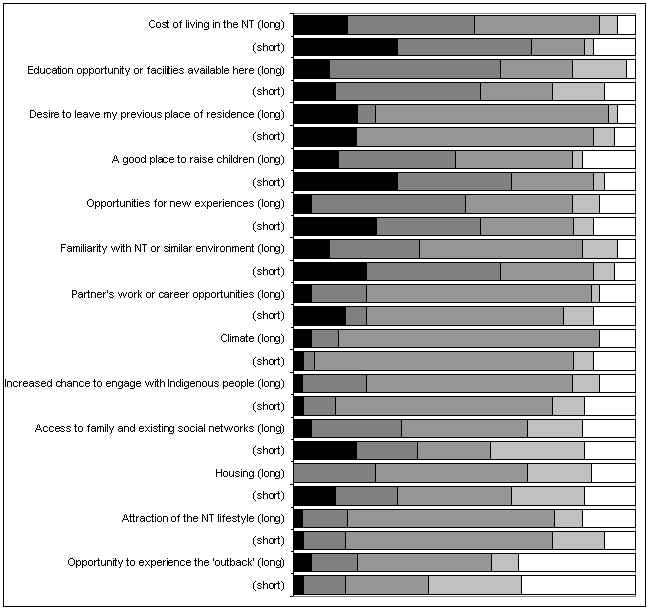
Figure 2: Social reasons for coming to the Northern Territory among dental professionals (proportion of respondents; dark: very important; mid-grey: indifferent; white: not at all important; priorities sorted from high to low for long-stayers, ie people staying >5 years).
Factors influencing decision to stay in the NT
Four components accounted for 64% of the variation in the original 13 variables related to factors influencing dental workers decision to stay in the NT (Fig 3).
The first component (24% of variation) broadly reflected work related activities influencing dental workers to stay. The second (21%) strongly reflected the NT lifestyle and community factors. Factors reflecting satisfaction with the professional working environment associated with dental workers staying in the NT accounted for 15% of variation, while component four, reflecting contentment with living in the NT (no reason to leave or to move; and to a lesser degree opportunity to be involved in activities more difficult to access in larger communities) accounted for 10%.
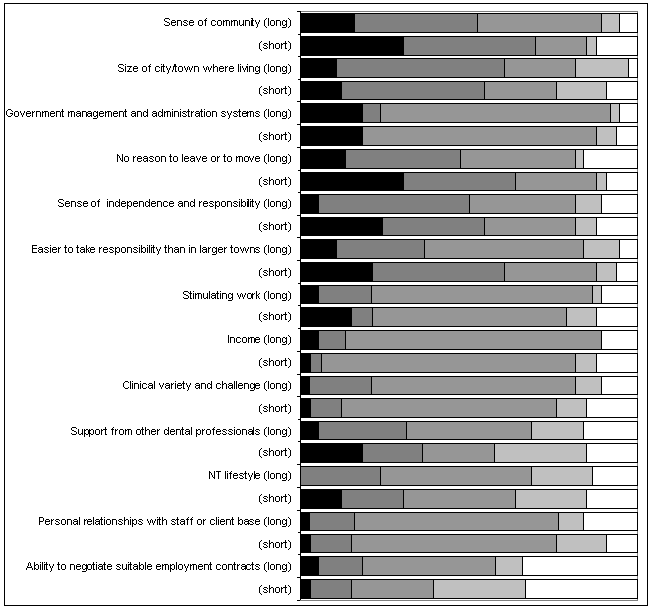
Figure 3: Reasons for staying in the Northern Territory among dental professionals (proportion of respondents; dark: very important; mid-grey: indifferent; white: not at all important; priorities sorted from high to low for long-stayers, ie people staying >5 years).
Factors influencing decision to leave the NT
A four-factor solution was obtained for the 20 variables relating to work factors influencing dental workers decision to leave in the NT (Fig 4). The four factors accounted for 77% of the variation in the original 20 variables. The first component (27% of variation) reflected strongly factors relating to the structural work environment (with the exception of plans to undertake further study, although this may be because of the type of work dental workers were performing in the work environment in the NT). Component two (25%) reflected disappointment in career expectations. The third component (16%) generally reflected structural aspects of the dentists' work place and overlapped with a number of reasons in component 1. The fourth component (9%) is distinct from the other three components in that it clearly groups only declining value of practice goodwill and difficulties associated with leaving a practice unattended. This factor is less significant because it accounts for only 9% of variation and because only four respondents indicated these two reasons were important.
A two-factor solution was sufficient to summarise the variation for the 11 variables relating to social factors influencing dental workers decision to leave in the NT (Fig 5). The two factors accounted for 68% of the variation in the original 11 variables.
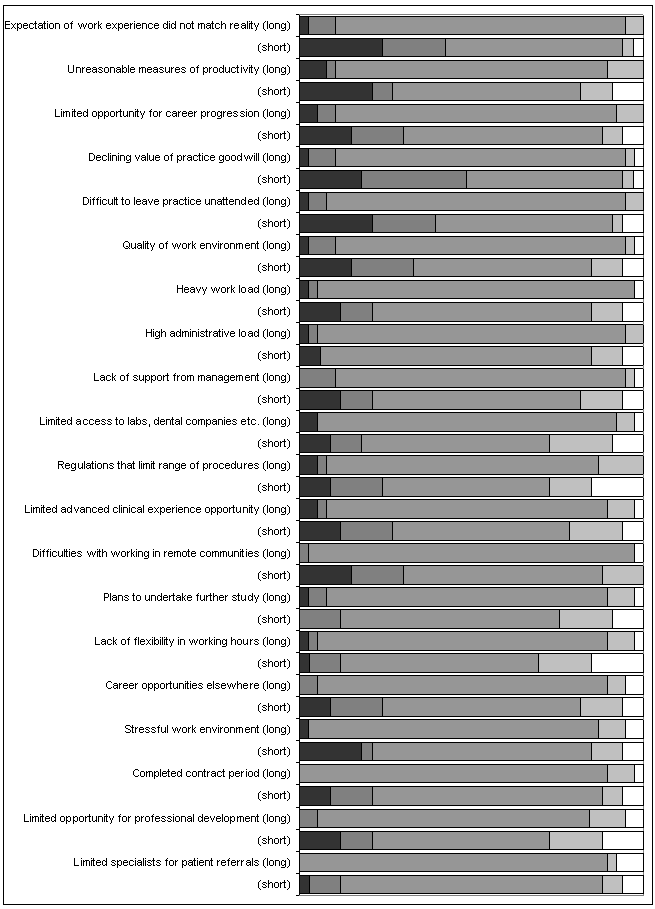
Figure 4: Work-related reasons for leaving the Northern Territory among dental professionals (proportion of respondents; dark: very important; mid-grey: indifferent; white: not at all important; priorities sorted from high to low for long-stayers, ie people staying >5 years).
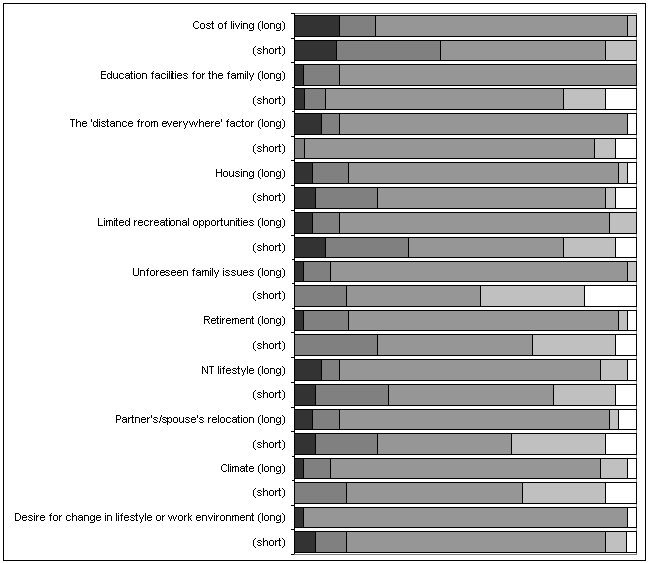
Figure 5: Social reasons for leaving the Northern Territory among dental professionals (proportion of respondents; dark: very important; mid-grey: indifferent; white: not at all important; priorities sorted from high to low for long-stayers, ie people staying >5 years).
The first component grouped 10 of the 11 reasons and summarised 51% of variation. While reflecting a general dissatisfaction with the NT, this component also included retirement and unforeseen family issues. The only reason not to load on this component was partner/spouse relocation, which was the highest loaded reason on the second rotated component and summarised a further 17% of the variation in the data. The second component also grouped several social reasons for leaving the NT.
Relationship between composite components and stay length
The relationships between the reasons underpinning respondents' decisions to come, stay or leave the NT and length of stay can be summarised as follows:
- Work-related decisions to come to the NT:
- Those who listed financial incentives, work with Indigenous people, personal career development, variety in dental treatment, work in good clinics, and work with experienced professionals (Component 1) as reasons to come to the NT tended to be short stayers, suggesting that their expectations related to work conditions and type of work may not have been met.
- Similarly, those who listed financial incentives, positive prior work experience, and not their partner's relocation to the NT (Component 4) as reasons to come, also tended to be short stayers.
- Those who listed financial incentives, work with Indigenous people, personal career development, variety in dental treatment, work in good clinics, and work with experienced professionals (Component 1) as reasons to come to the NT tended to be short stayers, suggesting that their expectations related to work conditions and type of work may not have been met.
- Social-related decisions to come to the NT:
- Access to family and social networks, familiarity with the NT environment and, to a lesser degree, the extent to which climate was unimportant (Component 3) were responses associated with long stayers in the NT workforce.
- People who came for reasons related to the NT lifestyle, desire to leave previous place of residence, work opportunity, the chance to interact with Indigenous people and cost of living in the NT (Component 4) tended to be short stayers.
- Access to family and social networks, familiarity with the NT environment and, to a lesser degree, the extent to which climate was unimportant (Component 3) were responses associated with long stayers in the NT workforce.
- Factors influencing decision to stay in the NT:
- Long stayers were more likely to give the NT lifestyle, sense of community, and size of town (Component 2) as reasons to stay in the NT.
- Long stayers were also more likely to give as reasons to stay in the NT, work opportunities available in smaller communities not available in large ones and no reason to leave (Component 4).
- Long stayers were more likely to give the NT lifestyle, sense of community, and size of town (Component 2) as reasons to stay in the NT.
- Work factors influencing decision to leave the NT:
- People who listed heavy workload, stressful work environment, high administrative load, lack of flexibility with working hours, quality of work environment, lack of support from management, unreasonable measures of productivity, and limited number of specialists for patient referrals; and leaving for further study (Component 1) tended to stay less than 5 years.
- Similarly the few respondents who thought that declining practice goodwill and difficulties associated with leaving the practice unattended as important (Component 2) did not stay for long.
- People who listed heavy workload, stressful work environment, high administrative load, lack of flexibility with working hours, quality of work environment, lack of support from management, unreasonable measures of productivity, and limited number of specialists for patient referrals; and leaving for further study (Component 1) tended to stay less than 5 years.
Context to numerical data is provided in comments from respondents. The following are synopses of the views of those 31 respondents (44%) who provided added detail about work as a dental professional in the NT.
Short stayers primarily commented on why they had left. Some may come back:
I am considering going back to the NT for a longer period after enjoying a two month locum.
Limited child care facilities and job opportunities influenced decision to leave but we really loved our time in the NT and may return again when the children are older.
For others the reasons for leaving were purely personal:
Too far from family and social networks.
Job opportunities seemed far better in Perth than Darwin so I moved on completion of my studies, by which time I had married.
Will leave when posted to another location.
Some enjoyed the lifestyle but left because of problems with management and facilities:
The Territory was a wonderful place to work and live. The main problem was the government bureaucracy and poor state of clinics in remote areas.
My wife and I made many close friends, more so than in any other locality. Working conditions in the public sector were primitive and very uncomfortable and morale extremely low. I particularly enjoyed working with indigenous people, but conditions in the clinics in Aboriginal districts were appalling.
I loved living in the NT - the lifestyle and people were great but ... facilities were appalling, the service grossly under funded and waiting lists were years long. On a number of occasions I was forced to offer rudimentary treatment to patients in the corridor because their wheelchairs would not fit through the surgery doors and they were too heavy to lift. On average 7 out of 10 patients had Hepatitis C, many with significant psychological problems and complex medical histories. Conditions in remote communities were far worse than other remote areas I have worked.
And then there were those whose disenchantment with management brooked no qualification:
Lack of coherent management and too much bureaucracy.
Renegotiation of the existing contract was left until one week before it expired, so we sought other jobs.
Public dental services are grossly under-resourced. Facilities in the area that I worked in were poor and the salary offered in the public clinics was a joke. Very difficult to retain health professionals unless local schools are up to standard.
Long stayers were mostly more charitable, even if they had eventually left the NT:
Darwin offers lots of opportunities but other dentists outside Darwin don't know enough about the lifestyle and other positives.
After nearly 25 years in Darwin I want to experience something else ... but it was a very happy and satisfying time
I love the Territory lifestyle but the cultural activities in SA are much wider and more varied.
I have enjoyed opportunities to learn about cultural differences from working with Indigenous people, but the insensitivities/incompatibility of mainstream culture and organisational structures and cultures has been ... character building and worrying.
But some left dispirited after substantial periods. They had a variety of reasons but all were critical of government health services:
In the end it was mainly the isolation and small town factor that was a problem. Oh, and did I mention THE HEAT. I would not continue work for government for longer than two years due to low wages, loss of professional skills because government clinics provide only basic dental treatment; too much bureaucracy, and poor morale.
I still love the Territory but am leaving because of the government dentistry bureaucracy and the poor state of the remote clinics. I appreciate the difficulties in supplying services in remote areas but the inequality displayed by the government dental service and glossed over excesses led me to become totally disenchanted.
The public health system is strained and poorly managed. It is very top heavy with management and administration staff and there are not enough clinicians for the work load.
Finally, many respondents, particularly the long stayers, suggested a variety of incentives for attracting and retaining dental professionals in the NT. These included:
We had good friends living in town who made initial experiences most enjoyable, so we stayed. There is a big responsibility for managers and those already employed to be welcoming and supportive of newcomers, both personally and professionally.
A bonus at the end of a three year contract is likely to persuade people to stay.
Feel strongly that local cadets should be supported to obtain qualifications.
Government scholarship for NT students to complete a dental degree with bonding for three years after graduation
Recruitment and retention will only be optimum when local training is available. Mentoring would also be good.
NT needs more local training opportunities and higher salaries for dentists.
Should establish an undergraduate or post graduate module introducing practitioners to service provision in rural/remote locations. It would prepare those with interests in public health and give a profile within dentistry to those practitioners who choose to work in public health.
Methodological considerations
This study was conducted as a pilot study of professional mobility with a focus on dental professionals and the length of time they stayed in the NT. In both absolute and relative terms there are fewer dental professionals in the NT than in other jurisdictions in Australia. Thus, although the survey response rate was good, the total sample size for all analyses reported in this document was only 71. This limits the ability to include a large number of explanatory variables in a single multivariate adjusted logistic regression, and precluded establishing models that included socio-demographic variables with the composite component scores relating to work and social factors affecting decisions by respondents to come, stay and leave the NT. However, although all findings should be interpreted with caution, the direction of associations should be relatively reliable for the models presented. Care should also be taken in interpretation of adjusted odds ratios and composite component scores, particularly where components containing different reasons for coming, staying or leaving the NT included reasons that loaded positively and negatively on the same component. The final reason for caution is that almost certainly some people who have been in the NT for <5 years will stay for longer, thus affecting the responses of short stayers.
Despite these constraints, the analyses were able to explain 60-80% of the variation in responses. One reason for that is likely to be the methodological approach of interviewing a sample of dental professionals before designing the questionnaire, thus ensuring that the questions asked were likely to be relevant to the study population. A more generic survey may have explained far less.
Impact of turnover (mobility)
Nearly half of the 31 respondents (48%) to questions related to staff turnover reported the loss of at least one staff member during the previous 12 months, with consequent disruption to normal clinic operations the most commonly reported effect of turnover (46%). For 21% of respondents, staff loss had direct financial costs and resulted in the loss of critical experience.
Conclusion
This study offered some support for the theory that individuals with prior experience of similar environments are more likely to work in rural areas29,31, in that nearly half the associates and a fifth of the dentists spent their high school in the NT or a rural area elsewhere in Australia. However, many of the dentists in particular had grown up abroad and neither place of birth nor home while at high school was correlated with length of stay. What was important among all long-stayers was the existence of a strong social network in the NT when they arrived, and a familiarity with the environment, including the climate.
This contrasted with the short stayers who were likely to come to the NT for financial reasons or with high expectations for the type of dental work they could practice. For short stayers, financial incentives were significant in two of the components suggesting that, while high income may be an important attractant of dental professionals to the NT, the people they attract are unlikely to stay for extended periods.
The mobility pattern for dental professionals in the NT suggests that social, not work-related, factors are most important for the long stayers. Such people appear to be embedded in the community at many levels: They are more likely to be involved in social and cultural organisations than short stayers, often have or are buying their own home, enjoy the small size of the NT towns and cities, and are generally content with their way of life. However, short stayers are less likely to engage in community activities or to have made any long-term commitments to the NT. There was some evidence that these were deliberate strategies to reduce the emotional cost of relocation, as illustrated by the interviewee who noted: 'we came to experience the NT lifestyle and to take the opportunities offered by the skills shortage, but have no intention of staying longer than two years (the contract period). We socialise at the sports club but have not made many close friends. Our emotional support comes from friends down south - we talk to them frequently through email and on the phone'.
Apart from a few dental professionals in the NT who had trouble establishing or maintaining their practices, or who left to retire or for further study, the main reasons people left in five years or less were related to the stresses of work. The extent to which these were trigger factors that precipitated departure52, or were part of a general disenchantment with NT living, was unclear but the consistent criticism of the management of government dental services, and the unfavourable comparison with remote area dental services in other places, suggests poor government administration was the major driving force behind rapid departure.
The high staff turnover rate among allied health professionals incurs high costs and results in a loss of valuable skills54. Shortages of dental professionals, as with other professional groups, also has flow-on effects; dentists are essential to the effective functioning of a modern society. There are thus good reasons for recruiting people to the NT who will stay for extended periods.
The principal message from the study is that staying is associated with enjoyment of the lifestyle associated with the NT. People who choose that lifestyle are likely to stay, especially if they are familiar with the environmental and professional challenges particular to the NT. And if they are not, communities can play an important role in integrating them so that they have the local support necessary to work through the challenges. Veitch and Grant33 describe a successful strategy for achieving this objective. The evidence presented shows that enticing dental professionals to work in NT with high salaries, promises of adventure and the opportunity to work with Indigenous people, but without warning them of the need to work hard in a climate that is sometimes difficult, and with management that can be perceived as unsupportive, and they will soon leave for more comfortable practices.
Advice volunteered by several dental professionals that recruitment and retention could be enhanced by the training of local people, preferably in the NT, is consistent with these conclusions. 'Grow your own' strategies55, where local people are trained to provide rural health care, have a high probability of retention as illustrated by the widespread utilisation of the community health worker model for the delivery of heath care (for a review of these successes56), but have a long lead time. Recruiting dental professionals from the region, or those familiar with the place and with existing social networks is an obvious solution, but given the limited number of NT graduates in Australian dental schools and the absence of local training facilities, this has limited application. In the short to medium term, providing new recruits and their families with a supportive network to enhance their integration into the professional and social fabric of the community, as described by Bidwell57 and Veitch and Grant33, together with a package of attractive incentives, has the greatest potential for addressing the challenge of recruiting dental professionals to the NT and for retaining them.
There is also evidence that the management of NT government dental services undermines retention initiatives. Oral health services were generally perceived as poorly managed and unable to respond to the demands of high staff turnover in a proactive, cost-efficient manner. Public service clinicians felt undervalued, their concerns about the state of remote clinics and unreasonable performance expectations disregarded by management. Both private sector and public service dentists were disillusioned by, and resentful of expenditure incurred when locums are imported to provide services that local dental professionals expect that they could provide, at a fraction of the cost if planning was more effective and flexible delivery models were considered. Under these conditions organisational morale is eroded making it more likely that departures will be triggered, despite the financial incentives offered. Given the tough environment of the NT it seems curious that something as mundane as administrative deficiencies could be a primary reason for departure, but while clinicians are in demand and viable alternatives exist, professionals are unlikely to settle for an inefficient and unrewarding work experience.
To answer the question posed regarding the need to tailor approaches to recruitment and retention for the NT: the issues raised by dental professionals, lifestyle and workforce management, are not substantially different to those faced by rural and remote allied health workforces elsewhere. They are not particular to the geography or demography of the region. Prior research indicates that there are no easy solutions to retention issues, but that effective planning and community involvement in the selection and induction of recruits can go some way to reducing turnover33,55,57. Given the costs associated with recruiting and keeping individuals with no prior connection to the NT, the solution may lie in taking a long-term view of the issue. Committing resources to encouraging Territorians to consider a career in dentistry, providing them with training opportunities (eg through scholarships, or local training facilities) and role models who are satisfied with their career options locally, may assist in stabilising workforce turnover in the future. In the meanwhile, addressing the requirements for professional and personal satisfaction within the existing workforce will build morale and organisational loyalty.
Acknowledgements
The assistance of the Australian Dental Association (NT branch) and the Australian Dental Therapists Association (NT branch) with recruiting volunteers to participate in the in-depth interviews, and permission from the Dental Registration Board to utilize the REGIS database as the sampling frame is gratefully acknowledged. The authors are also grateful for advice provided by their colleagues Mary Beneforti, Steve Guthridge, Ros Moye, Tom Wilson and Martin Young. This study, one in a proposed series examining the mobility of professionals in the NT, was conducted under permit number HO5020 from the Human Ethics Committee of Charles Darwin University. This study was funded by a Charles Darwin University Research Grant (2005/2006).
References
1. Best J. Rural Health Stocktake Advisory Paper. Canberra, ACT: Commonwealth Department of Health and Aged Care, 2000.
2. Government of Northern Territory. Building our population. Darwin, NT: Department of the Chief Minister, Northern Territory Government, 2004.
3. Carson D. The nature of movement into and out of the Northern Territory as shown by the 1991 census. Canberra: Australian Bureau of Statistics, 1994.
4. Szuster FSP, Spencer AJ. Dental practitioner statistics, Australia, 1994. Adelaide: University of Adelaide, 1997.
5. Teusner DN, Spencer AJ. Projections of the Australian dental labour force. Report no 1. Canberra: Australian Institute of Health and Welfare, 2003.
6. Teusner DN, Spencer AJ. Dental labour force, Australia 2000. AIHW cat no DEN 116. Canberra: Australian Institute of Health and Welfare, 2003.
7. Teusner DN, Mihailidis S, Carter KD, Spencer AJ. The South Australian dental labour force. Report no 5. Canberra: Australian Institute of Health and Welfare, 2005.
8. Brennan DS, Spencer AJ, Slade GD. Provision of pubic dental services in urban rural and remote locations. Community Dental Health 1996; 13: 157-162.
9. Reisine JT. Dental disease and work loss. Journal of Dental Research 1984; 63: 1158-1161.
10. Steele JG, Sanders AE, Slade GD, Allen PF, Lahti S, Nuttal N et al. How do age and tooth loss affect oral health impacts and quality of life? A study comparing two national samples. Community Dentistry and Oral Epidemiology 2004; 32: 107-114.
11. Akifusa S, Soh I, Ansai T, Hamasaki T, Takata Y, Yohida A et al. Relationship of number of remaining teeth to health-related quality of life in community-dwelling elderly. Gerodontology 2005; 22: 91-97.
12. Ng SKS, Leung WK. Oral health-related quality of life and periodontal status. Community Dentistry and Oral Epidemiology 2006; 34: 114-122.
13. Schwarz E. Access to oral health care - an Australian perspective. Community Dentistry and Oral Epidemiology 2006; 34: 225-231.
14. Spencer AJ, Teusner DN, Carter KD, Brennan DS. The dental labour force in Australia: the position and policy directions. Report no 2. Canberra: Australian Institute of Health and Welfare, 2003.
15. Hugo G. The economic implications of emigration from Australia. Canberra: Bureau of Immigration and Population Research, 1994.
16. Khoo S-E. Immigration issues in Australia. Journal of Population Research and NZ Population Review 2002; (September): 67-78.
17. Harris M, Tong K-K, Tseng Y-P. Optimal employee turnover rates: theory and evidence. Report no 19/02. Melbourne: Melbourne Institute Working Paper Series, 2002; 19.
18. Blakemore AE, Hoffman DL. Seniority rules and productivity: an empirical test. Economica, New Series 1989; 56(223): 359-371.
19. O'Brien-Pallas L, Duffield C, Hayes L. Do we really understand how to retain nurses? Journal of Nursing Management (UK) 2006; 14: 262-270.
20. Kingma M. Nursing migration: global treasure hunt or disaster-in-the-making? Nursing Inquiry 2001; 8: 205-212.
21. Lau T, Kumar S, Robinson E. New Zealand's psychiatrist workforce: profile, recruitment and retention. Australian and New Zealand Journal of Psychiatry 2004; 38: 547-553.
22. Mrayyan MT. Nurse job satisfaction and retention: comparing public to private hospitals in Jordan. Journal of Nursing Management 2005; 13: 40-50.
23. Kamien M, Buttfield IR. Some solutions to the shortage of general practitioners in rural Australia. Part 1: Medical School selection. Medical Journal of Australia 1990; 153: 105-112.
24. Hays RB. Choosing a career in general practice: the influence of medical schools. Medical Education 1993; 27: 254-258.
25. Collins K, Jones ML, McDonnell A, Read S, Jones R, Cameron A. Do new roles contribute to job satisfaction and retention of staff in nursing and professionals allied to medicine? Journal of Nursing Management 2000; 8: 3-12.
26. Sourdif J. Predictors of nurses' intent to stay at work in a university health centre. Nursing and Health Sciences 2004; 6: 59-68.
27. Humphreys JS, Jones MP, Jones JA, Mara J. Workforce retention in rural and remote Australia: determining the factors that influence length of practice. Medical Journal of Australia 2002; 176(10): 472-476.
28. Chan CCA, McBey K, Basset M, O'Donnell M, Winter R. Nursing crisis: retention strategies for hospital administrators. Research and Practice in Human Resource Management 2004; 12(2): 31-56.
29. MacIsaac P, Snowdon T, Thompson R, Crossland L, Veitch C. General practitioners leaving rural practice in western Victoria. Australian Journal of Rural Health 2000; 8: 68-72.
30. Taylor J, Blue I, Misan G. Approach to sustainable primary health care delivery for rural and remote South Australia. Australian Journal of Rural Health 2001; 9: 304-310.
31. Laven GA, Laurence COM, Wilkinson D, Beilby JJ. Using the Australian Rural Background Study to inform rural and remote multidisciplinary health workforce planning research. In: Proceedings, 8th National Rural Health Conference, Central to Health: sustaining well-being in remote and rural Australia; 10-13 March 2005; Alice Springs, Australia, 2005.
32. Playford D, Larson A, Wheatland B. Going country: rural student placement factors associated with future rural employment in nursing and allied health. Australian Journal of Rural Health 2006; 14: 14-19.
33. Veitch C, Grant M. Community involvement in medical practitioner recruitment and retention: reflections on experience. Rural and Remote Health 4: 261. (Online) 2004. Available: www.rrh.org.au (Accessed 8 February 2007).
34. Kruger E, Tennant M. Oral health workforce in rural and remote Western Australia: practice perceptions. Australian Journal of Rural Health 2005; 13: 321-326.
35. DiMeglio K, Padula C, Piatek C, Korber S, Barrett A, Ducharme M et al. Group cohesion and nurse satisfaction: examination of a team-building approach. Journal of Nursing Administration 2005; 35: 110-120.
36. Yoder LH. Staff nurses' career development relationships and self-reports of professionalism, job satisfaction, and intent to stay. Nursing Research 1995; 44: 290-197.
37. Finn CP. Autonomy: an important component of nurses' job satisfaction. International Journal of Nursing Studies 2001; 38: 349-357.
38. Chaboyer W, Williams G, Corkill W, Creamers J. Predictors of job satisfaction in remote hospital nursing. Canadian Journal of Nursing Leadership 1999; 12: 30-40.
39. Shapiro JP. Nurses are overworked, stressed, and hard to find. US News and the World Report 2001; 130(24): 54-57.
40. Irvine DM, Evans MG. Job satisfaction and turnover among nurses: integrating research findings across studies. Nursing Research 1995; 44: 246-253.
41. Australian Institute of Health and Welfare. Victorian Oral Health Services Labour Force Planning. Melbourne: Victorian Department of Human Services, 2002.
42. Luzzi L, Spencer AJ, Jones K, Teusner D. Job satisfaction of registered dental practitioners. Australian Dental Journal 2005; 50: 179-185.
43. Boles AL, J YG, Peterson DA, Kilawee L. Lifestyle satisfaction of rural, South Dakota, family practice physicians. South Dakota Journal of Medicine 2000; 53: 235-240.
44. Wainer J. Work of female rural doctors. Australian Journal of Rural Health 2004; 12: 49-53.
45. Jones JA, Humphries JS, Adena MA. Doctor's perspectives on the viability of rural practice. Rural and Remote Health 4: 305. (Online) 2004; Available: www.rrh.org.au (Accessed 8 February 2007).
46. APS. Survey report: Why do you live where you live? Melbourne: The Australian Psychological Society, 2005.
47. Mitchell TR, Holtom BC, Lee TW. How to keep your best employees: Developing an effective retention policy. Academy of Management Executive 2001; 15: 96-109.
48. Giosan C. Predictors of job embeddedness. The Id 2003; 1: 51-53.
49. Holtom BC, O'Neill BS. Job embeddedness: a theoretical foundation for developing a comprehensive nurse retention plan. Journal of Nursing Administration 2004; 24: 216-227.
50. Belcher S, Kealey J, Jones J, Humphreys J. The VURHC Rural Allied Health Professional Recruitment and Retention Study. Melbourne: Victorian Universities Rural Health Consortium, 2005.
51. March JG, Simon HA. Organisations. London: Wiley Press, 1958.
52. Hays RB, Veitch PC, Cheers B, Crossland L. Why doctors leave rural practice. Australian Journal of Rural Health 1997; 5: 198-203.
53. Duda, RO, Hart PE and Stork DG. Pattern Classification. New York: Wiley, 2001.
54. Seavey D. The cost of frontline turnover in long-term care. Washington, DC; Institute for the Future of Aging Services, 2004.
55. CSRHA. The rural kaleidoscope: a guide on promising practices to diversifying California's rural healthcare workforce. Sacremento, CA: California State Rural Health Association, 2005.
56. Irwin A, Scali E. Action on the social determinants of health: learning from previous experiences. Geneva: Commission on Social Determinants of Health, WHO, 2005.
57. Bidwell S. Successful models of rural health service delivery and community involvement in rural health: international literature review. Christchurch: Centre for Rural Health, 2001.

